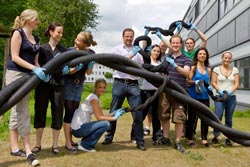Sunlight induced DNA Crash

Sunlight can damage DNA: Dr. Winfried Barchet (centre), and his co-workers at the Institute of Clinical Chemistry and Clinical Pharmacology visualize their findings using black tubing to represent the DNA double helix. Nadine Gehrke (on the far left), Christina Mertens (far right) and Thomas Zillinger (fourth from the right) share first authorship on the publication.<br>(c) Photo: Anna-Maria Herzner/UKB<br>
Scientists of the University Hospital Bonn, Germany have now discovered which signaling pathway of the innate immune system promotes autoimmune symptoms following sun-induced DNA damage. The results are now published online in the academic journal Immunity.
Lupus erythematosus (LE) is an autoimmune disorder in which the immune system erroneously attacks the body’s own tissues. Where most people merely suffer sunburn, LE prone patients may develop severe redness and inflammation in sun-exposed skin. Immunologists of the University Hospital Bonn together with the Dermatologists Profs. Thomas Tüting and Jörg Wenzel have now discovered an immune mechanism that triggers LE skin lesions.
„We have shown how the UV component of sunlight may cause DNA damage in cells, and in consequence lead to an alarm response from the innate immune system“, reports Dr. Winfried Barchet, head of the Emmy Noether-research team „Immunorecognition of viral nucleic acids in the cytosol“ at the Institute of Clinical Chemistry and Clinical Pharmacology at the university clinics of Bonn.
How DNA damage produces a false alarm
High-energy UV irradiation damages DNA in the nuclei of living cells that in consequence perish, and release the UV-altered DNA. In lupus patients this triggers a troublesome signaling cascade: „The innate immune system usually detects viruses via their nucleic acids. Here however, this state of emergency is declared erroneously due to the crash in the body’s own DNA,“ says Dr. Barchet. The majority of the innate immune receptors that detect viral nucleic acids and in consequence activate inflammatory immune defense mechanisms are now known.
„For the induction of lupus symptoms, according to our data, the decisive role is played by the very recently discovered immune receptor cGAMP-Synthase (cGAS)“, says Dr. Barchet. DNA released from dying cells is taken up by immune cells and then degraded by the enzyme TREX1. When the cellular DNA is UV damaged, however, TREX1 is ineffective according to the results of the Bonn researchers. Damaged DNA accumulates and activates the cGAS signaling pathway, thus ringing a false alarm for the immune system
The researchers were also able to support this concept with a mouse model in which a gene defect makes them prone to develop lupus-like autoimmune disease. When the immunologists injected DNA damaged by UV-light into the skin, the animals locally developed typical lupus symptoms: skin swelling and inflammation, infiltration of immune cells that eventually attacked skin tissue. Control injections of intact DNA, in contrast, did not cause such skin alterations.
„These signaling events may explain why lupus patients are prone to UV-light induced skin lesions“, says the researcher. This study is the first to implicate the cGAS receptor in this autoimmune disorder. Dr. Barchet envisions potential targets for novel lupus therapies: „With a suitable inhibitor of the cGAS signaling cascade, it may become possible to suppress sunlight induced symptoms of the disease. On the other hand, it is puzzling why the immune system has evolved and maintained such a potentially harmful mechanism. We believe that in healthy individuals it must have an important function in the defense against pathogens that we would very much like to understand as well,“ says Dr. Barchet.
Dr. Barchet is a member of the ImmunoSensation cluster of excellence (Speaker: Prof. Dr. Gunther Hartmann) of the University of Bonn that is funded for 5 years with a total of 30 million Euro.
Publication: „Oxidative Damage of DNA Confers Resistance to Cytosolic Nuclease TREX1 Degradation and Potentiates STING-Dependent Immune Sensing”, Fachjournal „Immunity“
Contact:
Dr. rer. nat. Winfried Barchet
Leiter der Emmy-Noether-Gruppe „Immunerkennung viraler Nukleinsäuren im Zytosol“
Institut für Klinische Chemie und Klinische Pharmakologie
Tel. 0228/28751146
E-Mail: Winfried.Barchet@ukb.uni-bonn.de
Weitere Informationen:
http://dx.doi.org/10.1016/j.immuni.2013.08.004
Publication
Media Contact
All latest news from the category: Health and Medicine
This subject area encompasses research and studies in the field of human medicine.
Among the wide-ranging list of topics covered here are anesthesiology, anatomy, surgery, human genetics, hygiene and environmental medicine, internal medicine, neurology, pharmacology, physiology, urology and dental medicine.
Newest articles

Silicon Carbide Innovation Alliance to drive industrial-scale semiconductor work
Known for its ability to withstand extreme environments and high voltages, silicon carbide (SiC) is a semiconducting material made up of silicon and carbon atoms arranged into crystals that is…

New SPECT/CT technique shows impressive biomarker identification
…offers increased access for prostate cancer patients. A novel SPECT/CT acquisition method can accurately detect radiopharmaceutical biodistribution in a convenient manner for prostate cancer patients, opening the door for more…

How 3D printers can give robots a soft touch
Soft skin coverings and touch sensors have emerged as a promising feature for robots that are both safer and more intuitive for human interaction, but they are expensive and difficult…





















